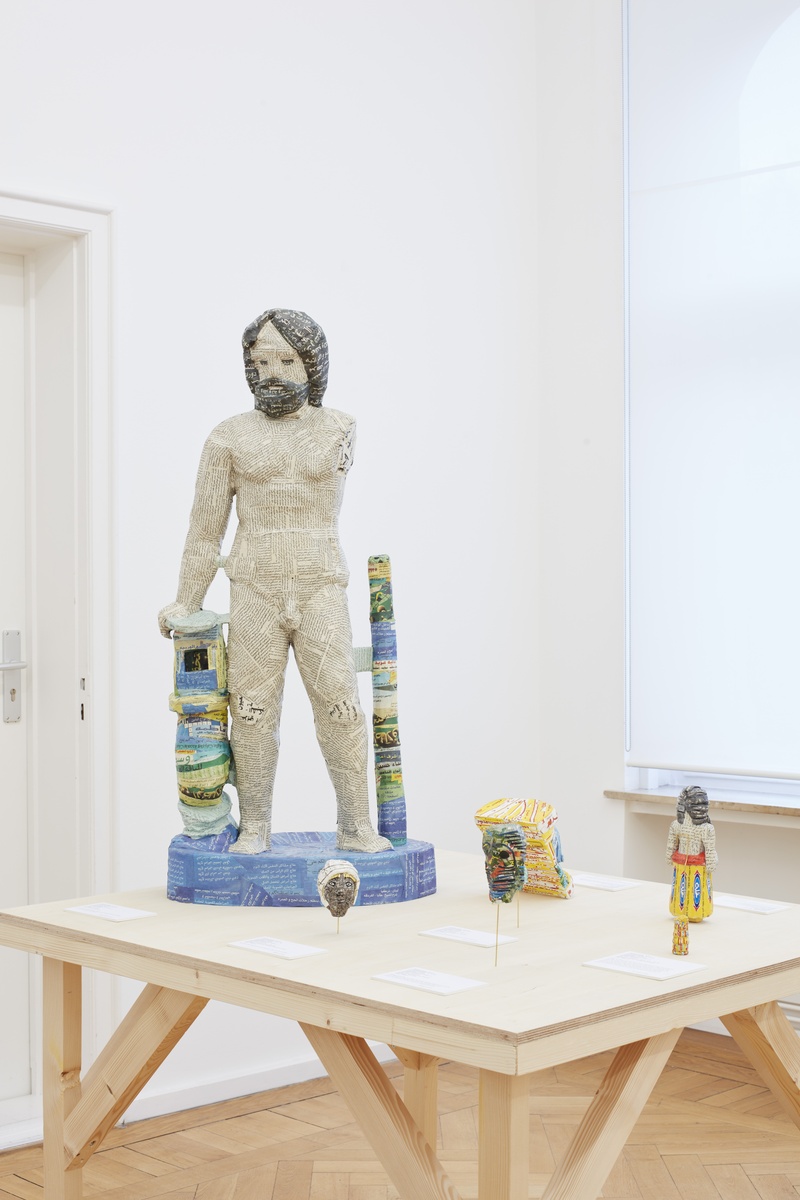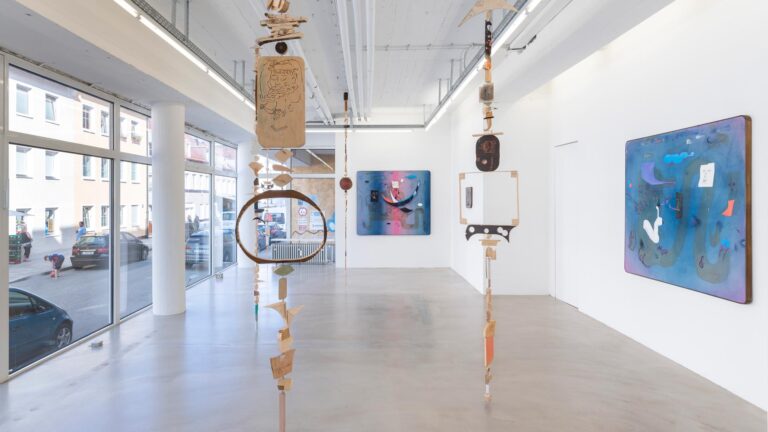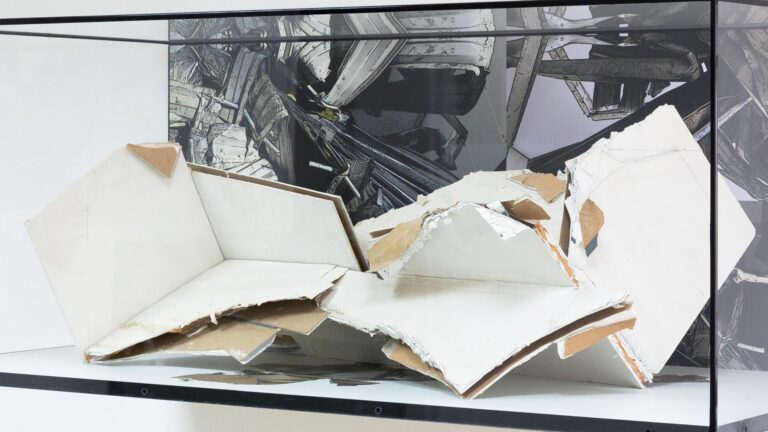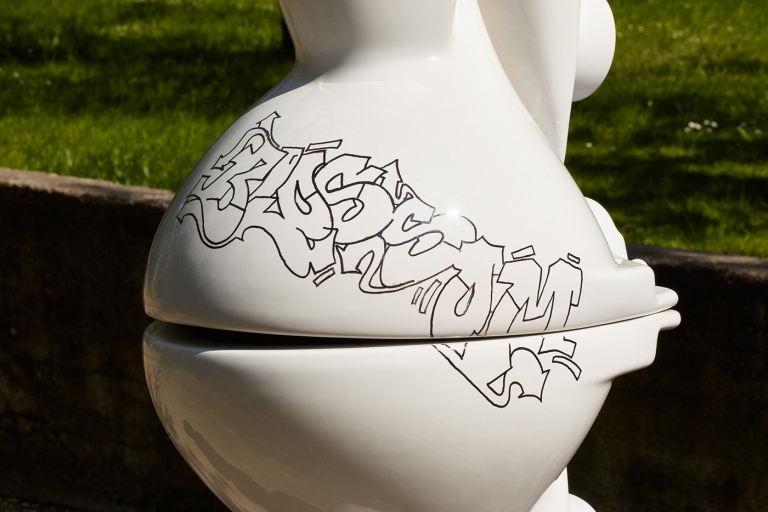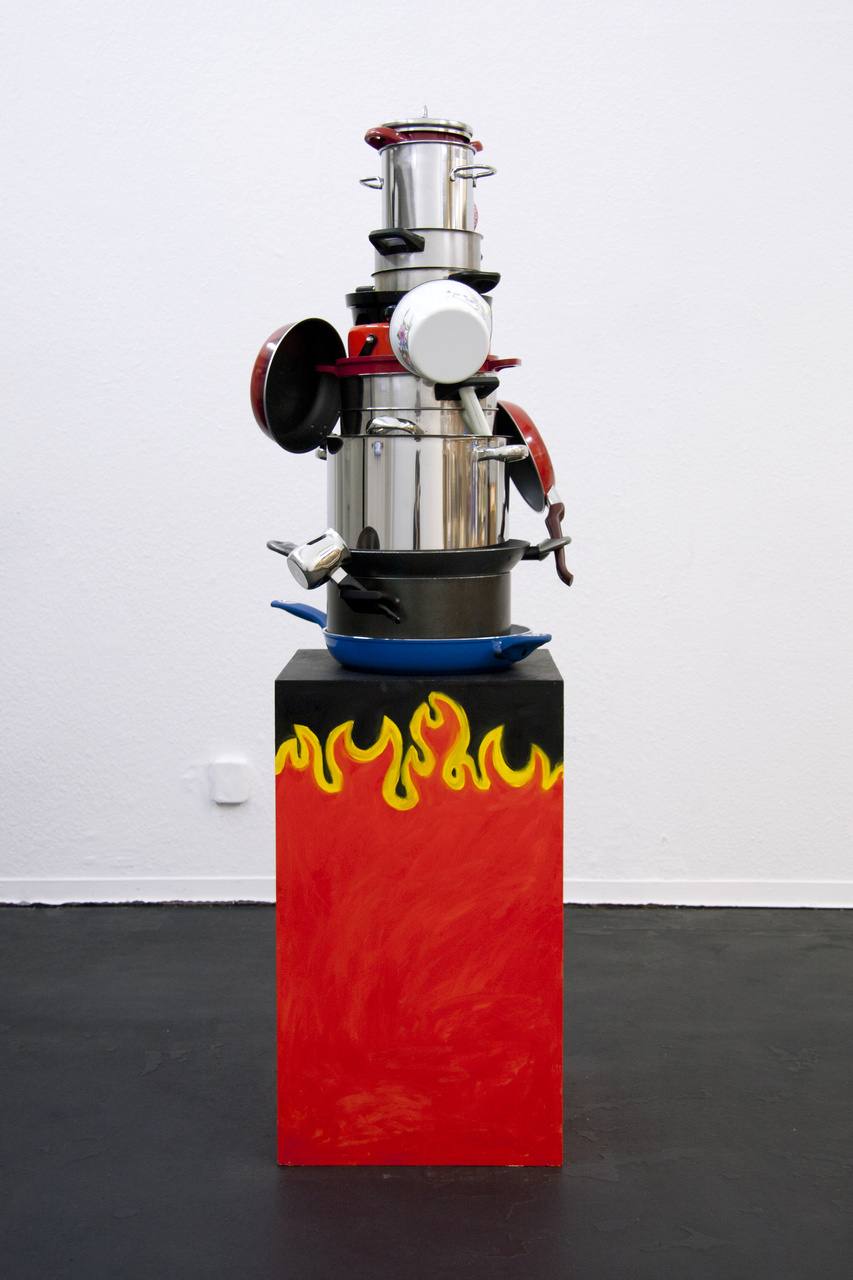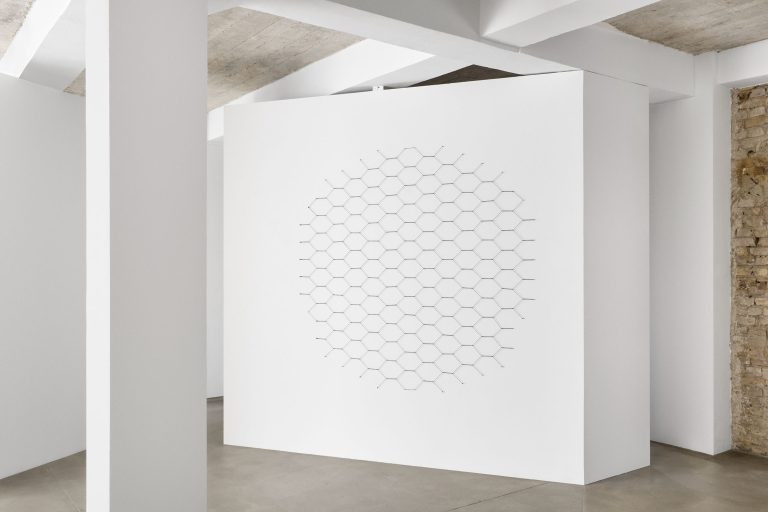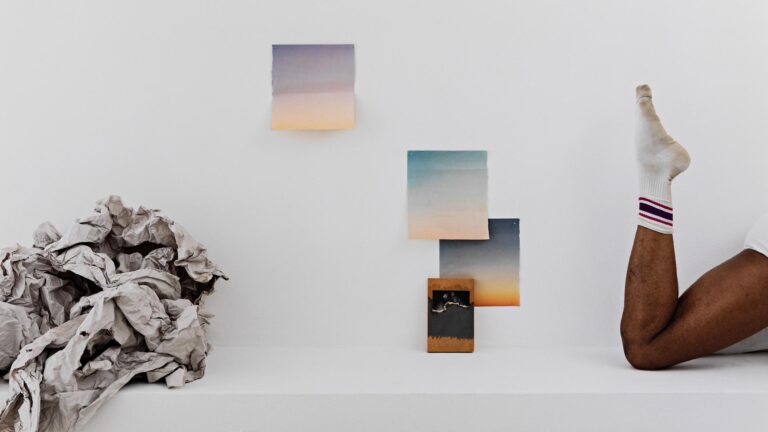Artist: Michael Rakowitz
Exhibition title: The invisible enemy should not exist
Venue: Barbara Wien, Berlin, Germany
Date: April 29 – August 20, 2016
Photography: Nick Ash, all images copyright and courtesy of the artist and Barbara Wien, Berlin
During the 2003 invasion of Iraq, Baghdad’s National Museum of Iraq, the home of a large collection of world heritage objects, was not protected. The unsecured building was looted, and approximately 15,000 objects disappeared, leaving a terrible void in the museum collection and the international collection of relics of human history.
For his first exhibition with Galerie Barbara Wien, Michael Rakowitz presents The invisible enemy should not exist, an ongoing project since 2007. It is a direct response to the pillage of Baghdad’s Museum, and a stirring homage to its former director, Dr. Donny George Youkhanna, who dedicated his time to recovering the missing artifacts until his death in 2011. It is also a reflection of Rakowitz’s own biographical background, as his mother’s family fled Iraq in 1946 to settle in the USA. Raised in New York, the artist now lives and works in Chicago.
The project’s title is a translation of “Aj-ibur-shapu”, which was the name of the main processional street that passed through the Ishtar Gate in ancient Babylon. The history of this legendary gate offers interesting parallels to Michael Rakowitz’s project, in part because its new location since its excavation in the early 20th century is in Berlin’s Pergamon Museum. In the 1950s, the Iraqi government reproduced a replica made from plaster and wood in Babylon. Michael Rakowitz has also devoted himself to the creation of replicas: true to scale reproductions of the objects looted from the National Museum of Iraq. His replicas are made of papier-mâché plastered with Arabic newspapers and the packaging of Middle Eastern food products sold in the United States. Rakowitz himself had never personally seen the missing objects. He gets his information through pictures and documentation in the University of Chicago’s Oriental Institute’s database and from Interpol’s website. His makeshift relics are mostly displayed upon a table designed to recreate the trajectory of Aj-ibur-shapu.
Black and white pencil drawings annex narrative episodes. In one drawing, for instance, Dr. Donny George Youkhanna appears behind drums, an unexpected position to the ignorant viewer. A caption tells us that the archaeologist used to play in a band called “99%” which covered songs by Deep Purple and Pink Floyd. Thus, the reason for the installation’s background soundtrack becomes clearer: Michael Rakowitz commissioned a band called Ayyoub to cover Deep Purple’s “Smoke on the Water” in Arabic, the ubiquitously played song of our time, which tells a story of senseless destruction and loss. (1)
Sites of display hold great importance in Michael Rakowitz’s work. His projects are often produced for a specific place and take note of the location’s history. For his piece May the arrogant not prevail – the title is an alternative translation of Aj-ibur-shapu – he used similar techniques of recycling product packaging to reproduce the Ishtar Gate, this time from the Iraqi government’s replica, and then exhibited it in a group show in Berlin’s Haus der Kulturen der Welt (2010). This impressive “garbage gate” surely produced a formidable symbolic resonance while on display in Berlin.
Yet, with the ongoing project, The invisible enemy should not exist, now on display at Barbara Wien, it is its movability which makes it operate (2): replicas of displaced national treasures are “transformed” into contemporary art sculptures and exhibited in a commercial gallery, thereby introducing them to the art market and potential ownership by collectors or institutions. When the British Museum acquired some of the project’s sculptures and displayed them within their Mesopotamian collection, it created a challenging tension. Rakowitz often plays with these different systems of value and trade with a delicious irony but also a substantive impact.
The artist’s commitment to fabricating the entire collection of the missing archaeological objects in papier-mâché could be seen as an almost Sisyphean labor in its absurd materiality. The non-preciosity of his replicas reveals the dreadful loss of the originals. They are evidently not strict counterfeits, but only “cheap” ghostly apparitions that paradoxically signify an absence by means of their own presence.
(Text by Gauthier Lesturgie)
(1) In “Smoke on the Water” the lyrics tell of the fire that members of Deep Purple witnessed from the other side of Lake Geneva when the Montreux Casino burned as Frank Zappa played there on December 4th, 1971.
(2) The project has been shown at venues such as at the Sharjah Biennial (2007), the Istanbul Biennial (2007), the Hessel Museum of Art in Annandale-On-Hudson, New York (2008), Modern Art Oxford (2009), the Hiroshima City Museum of Contemporary Art (2013), and the Oriental Institute, University of Chicago (2014). Parts of it are held in the following public collections: Van Abbemuseum, Eindhoven; The British Museum, London; Metropolitan Museum of Art, New York; Smart Museum of Art, University of Chicago, amongst others.
Michael Rakowitz (b. 1973, New York) is living and working in Chicago. His work has appeared in venues worldwide including the Istanbul Biennial (2015 and 2007), the Museum of Contemporary Art Chicago (2014), the Van Abbemuseum, Eindhoven (2013), dOCUMENTA (13) and the Museum of Modern Art, New York (2012), the 16th Biennale of Sydney (2008), and the Sharjah Biennial 8 (2007). He has had solo exhibitions and projects at the Museum of Modern Art, New York (2015), the Tate Modern in London (2010), the Kunstraum Innsbruck, and the mumok in Vienna (2004).
The invisible enemy should not exist is built with the assistance of: Melina Ausikaitis, Loo Bain, Ken Camden, Chelsea Culp, Steve Davy, Erin Foley, Megan Schvaneveldt Frank, Andrea Fritsch, Daniel Giles, Brooke Havlik, Robert Chase Heishman, Emily Kay Henson, Leonardo Kaplan, Yiran Liu, Aaron Menninga, Charles Miller, David Moré, Aay Preston-Myint, Auden O’Connell, Asli Ozdoyuran
Julie Potratz, Adam Liam Rose, Sana Sohrabi, Schuyler Smith, Min Song, Mauricio Urusquieta, Geraldine Vo. Dedicated to the memory of Selma Al-Radi, Sam Paley, and Dr. Donny George Youkhanna
Michael Rakowitz, The invisible enemy should not exist (Table 2, South room)
Table with 7 artifacts from cardboard, Middle Eastern packaging and newspapers, glue, museum, labels, 92 x 100 x 92cm
Michael Rakowitz, The invisible enemy should not exist (Table 2, South room)
Table with 7 artifacts from cardboard, Middle Eastern packaging and newspapers, glue, museum, labels, 92 x 100 x 92cm
Michael Rakowitz, The invisible enemy should not exist (Table 2, South room)
Table with 7 artifacts from cardboard, Middle Eastern packaging and newspapers, glue, museum, labels, 92 x 100 x 92cm
Michael Rakowitz, The invisible enemy should not exist (Table 2, South room)
Table with 7 artifacts from cardboard, Middle Eastern packaging and newspapers, glue, museum, labels, 92 x 100 x 92cm
Michael Rakowitz, The invisible enemy should not exist, 2007 – ongoing
2 tables with 29 artifacts from cardboard, Middle Eastern packaging and newspapers, glue, museum labels, sound and 4 drawings, 92 x 494 x 92cm
Michael Rakowitz, The invisible enemy should not exist, 2007 – ongoing
2 tables with 29 artifacts from cardboard, Middle Eastern packaging and newspapers, glue, museum labels, sound and 4 drawings, 92 x 494 x 92cm
Michael Rakowitz, The invisible enemy should not exist, 2007 – ongoing
2 tables with 29 artifacts from cardboard, Middle Eastern packaging and newspapers, glue, museum labels, sound and 4 drawings, 92 x 494 x 92cm
Michael Rakowitz, The invisible enemy should not exist, 2007 – ongoing
2 tables with 29 artifacts from cardboard, Middle Eastern packaging and newspapers, glue, museum labels, sound and 4 drawings, 92 x 494 x 92cm
Michael Rakowitz, The invisible enemy should not exist, 2007 – ongoing
2 tables with 29 artifacts from cardboard, Middle Eastern packaging and newspapers, glue, museum labels, sound and 4 drawings, 92 x 494 x 92cm
Michael Rakowitz, The invisible enemy should not exist, 2007 – ongoing
2 tables with 29 artifacts from cardboard, Middle Eastern packaging and newspapers, glue, museum labels, sound and 4 drawings, 92 x 494 x 92cm
Michael Rakowitz, The invisible enemy should not exist, 2007 – ongoing
2 tables with 29 artifacts from cardboard, Middle Eastern packaging and newspapers, glue, museum labels, sound and 4 drawings, 92 x 494 x 92cm
Michael Rakowitz, The invisible enemy should not exist (Table 3, South room)
Table with 5 artifacts from cardboard, Middle Eastern packaging and newspapers, glue, museum, labels, 92 x 100 x 92cm
Michael Rakowitz, The invisible enemy should not exist (Table 3, South room)
Table with 5 artifacts from cardboard, Middle Eastern packaging and newspapers, glue, museum, labels, 92 x 100 x 92cm
Michael Rakowitz, The invisible enemy should not exist (Table 3, South room)
Table with 5 artifacts from cardboard, Middle Eastern packaging and newspapers, glue, museum, labels, 92 x 100 x 92cm
Michael Rakowitz, The invisible enemy should not exist (Table 3, South room)
Table with 5 artifacts from cardboard, Middle Eastern packaging and newspapers, glue, museum, labels, 92 x 100 x 92cm
Michael Rakowitz, Stela fragment; relief carving shows two men wearing skirt and head band and four animals (lions) (IM23477) (Recovered, Missing, Stolen series), 2016
Middle Eastern packaging and newspapers, glue, 104 x 70 x 52cm
Michael Rakowitz, Stela fragment; relief carving shows two men wearing skirt and head band and four animals (lions) (IM23477) (Recovered, Missing, Stolen series), 2016
Middle Eastern packaging and newspapers, glue, 104 x 70 x 52cm
Michael Rakowitz, Stela fragment; relief carving shows two men wearing skirt and head band and four animals (lions) (IM23477) (Recovered, Missing, Stolen series), 2016
Middle Eastern packaging and newspapers, glue, 104 x 70 x 52cm

